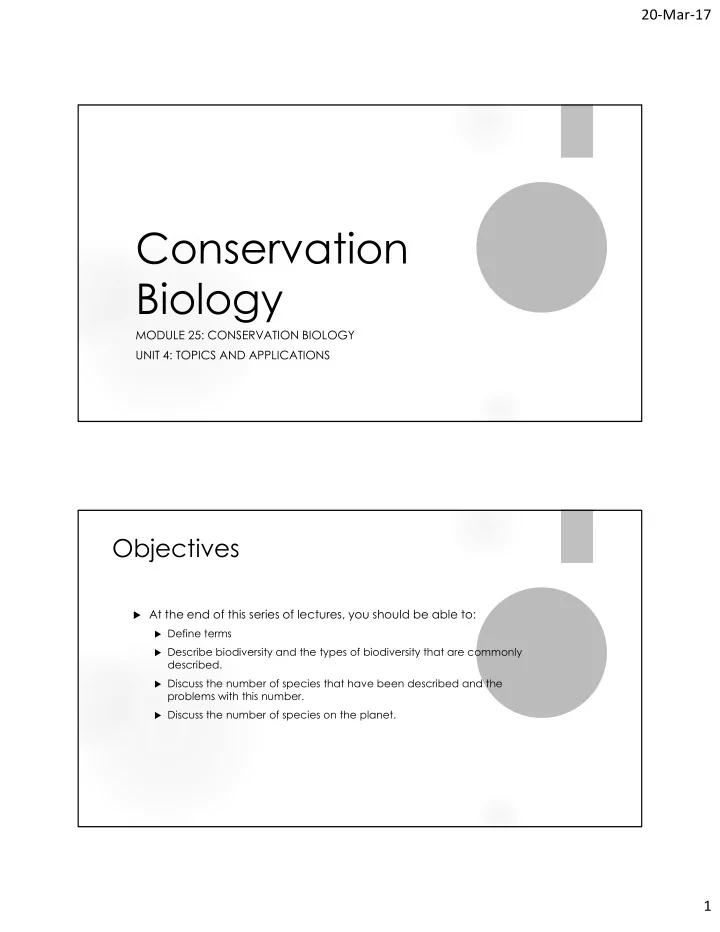

20‐Mar‐17 Conservation Biology MODULE 25: CONSERVATION BIOLOGY UNIT 4: TOPICS AND APPLICATIONS Objectives At the end of this series of lectures, you should be able to: Define terms Describe biodiversity and the types of biodiversity that are commonly described. Discuss the number of species that have been described and the problems with this number. Discuss the number of species on the planet. 1
20‐Mar‐17 Objectives Distinguish between and describe background and current extinction rates. Explain the causes of the threats to biodiversity. Describe the threats to biodiversity. Explain climate change. Describe conservation biology as a discipline. Defining biodiversity Biological Diversity Define diversity Conservation biologists routinely categorize biodiversity into three levels: Genetic diversity Species diversity Ecological diversity 2
20‐Mar‐17 How Many Species Have Been Described? 1.4 - 1.8 million species have been described and named. Why the range? No one has kept track of the species that have been named. Species 2000 Unidentified synonyms (one species multiple names) /homonyms (multiple species one name) Described/named species is a biased and poor estimator of global species richness. Linnean shortfall Centinelean extinctions 3
20‐Mar‐17 How Many Species Have Been Described? The description of species has not been random. Spatial – Temperate regions have been well described ~ The tropics have not. Size – Larger species tend to be described while smaller species are often undescribed. Taxonomic – The number of taxonomists working on a group is not proportional to the number of species within the taxonomic groups. Terrestrial - know more about terrestrial than aquatic systems How Many Species? We do not know. 12 million 100 million < 1 billion > 1 trillion 4
20‐Mar‐17 Background Extinction Rates Background extinction rate -- The natural extinction rate without human disturbance. Species last on average 10 million years. Assuming 10-100 million species on the planet, the background extinction rate should be 0.1-10 species per year. Current Extinction Rate Combines both natural extinctions and extinctions due to anthropogenic (human-caused) disturbance. Two methods are used to estimate the current rate of extinction. Species area relationship Observed extinction rate 5
20‐Mar‐17 Current Extinction Rates Current extinction rates are estimated to be 100 to 1000 times greater than the predicted background extinction rate. 10 – 10,000 species per year Threats to Biodiversity Threats to biodiversity spring from two major causes: Human population growth Increased standard of living Distribution of wealth 6
20‐Mar‐17 Human population growth The world’s human population is estimated to total ~ 7 billion. It is increasing by over 100 million annually. Optimal total human population is ~1.5 to 2 billion 7
20‐Mar‐17 Human population growth The human population has increased due to: High birth rates Declining mortality rates Reliable food supplies Improved sanitation Medicine Human population growth Humans appropriate approximately 40% of all potential terrestrial net primary productivity. 8
20‐Mar‐17 Increased Standard of Living We would need 3.5 Earths for the 6.8 people on the planet to live as we do. Human Disturbance The major threats to biodiversity are the result of human activity. Habitat destruction, degradation, and fragmentation Introduction of exotic species Overexploitation Increased spread of disease Pollution 9
20‐Mar‐17 Climate Change Solar Energy Some of the light that reaches the Earth’s surface is reflected by snow, ice, sand, water. Albedo Absorbed energy heats surfaces, evaporates water, and creates energy for photosynthesis. 2nd law of thermodynamics – Entropy Absorbed energy is reradiated as heat. 10
20‐Mar‐17 What are Greenhouse Gases? Natural gases Carbon dioxide (CO2) methane (CH4) water vapor Ozone Nitrous oxides Other greenhouse gases chloroflourocarbons These gases trap heat in the atmosphere What is Global Warming? Currently, global warming is occurring as increasing concentrations of greenhouse gases enter the atmosphere and trap heat. This is due to human domestic, industrial & agricultural practices. Carbon sources currently outweigh carbon sinks 11
20‐Mar‐17 Observations of Climate Change Global mean surface temperature increased 0.5°C in the last 100 years. 20th century was the warmest on record since the15th century 12 warmest years on record occurred in the last 16 years. Rapid rate of increase. Global Climate Models General Circulation Models Expected 1.5 to 6.1 ◦ C increase in next 100 years Warming greatest at poles, weakest at tropics Climates to become more continental (extremes) 12
20‐Mar‐17 Global Climate Models Global precipitation Changing spatial & temporal patterns Overall increase in volume & intensity In some regions, drought to become more common & severe Change in ocean currents and atmospheric patterns of circulation Rising ocean levels Thermal expansion Melting ice Biological Predictions Thomas et al (2004) 2050 Minimum 9-13% species extinctions maximum 21-32% species extinctions This is based solely on climate predictions, not synergistic, anthropogenic threat. Controversial 13
20‐Mar‐17 What is Conservation Biology? Applied branch of biology whose goal is the maintenance of: Biodiversity Genes, populations, species, ecosystems Ecological process Photosynthesis, natural selection What is Conservation Biology? Synthetic field Ecology Biogeography Landscape Ecology Population genetics Molecular genetics Economics Political Science Sociology Anthropology Philosophy 14
20‐Mar‐17 What is Conservation Biology? Crisis discipline Action is taken without complete knowledge Often reactive, ideally proactive Time is critical Working with available information and best intuition and creativity. Counter to most scientific educations Management of unprecedented, highly disrupted ecosystems What is Conservation Biology? Inexact Science Ecological systems are complex and dynamic Small data sets Looks at systems on wide gradient of scales Lots of noise Situations are unique, must be handled case-by-case 15
20‐Mar‐17 What is Conservation Biology? Value-laden Science is value-free & objective Mission-oriented Advocacy debate What is Conservation Biology? Long time scale Traditional “Conservation” and “Management” Maximum sustainable yields Economic feasibility Immediate satisfaction – consumerism In perpetuity Eternal vigilance Ex. U.S. Arctic National Wildlife Refuge (oil) 16
Recommend
More recommend